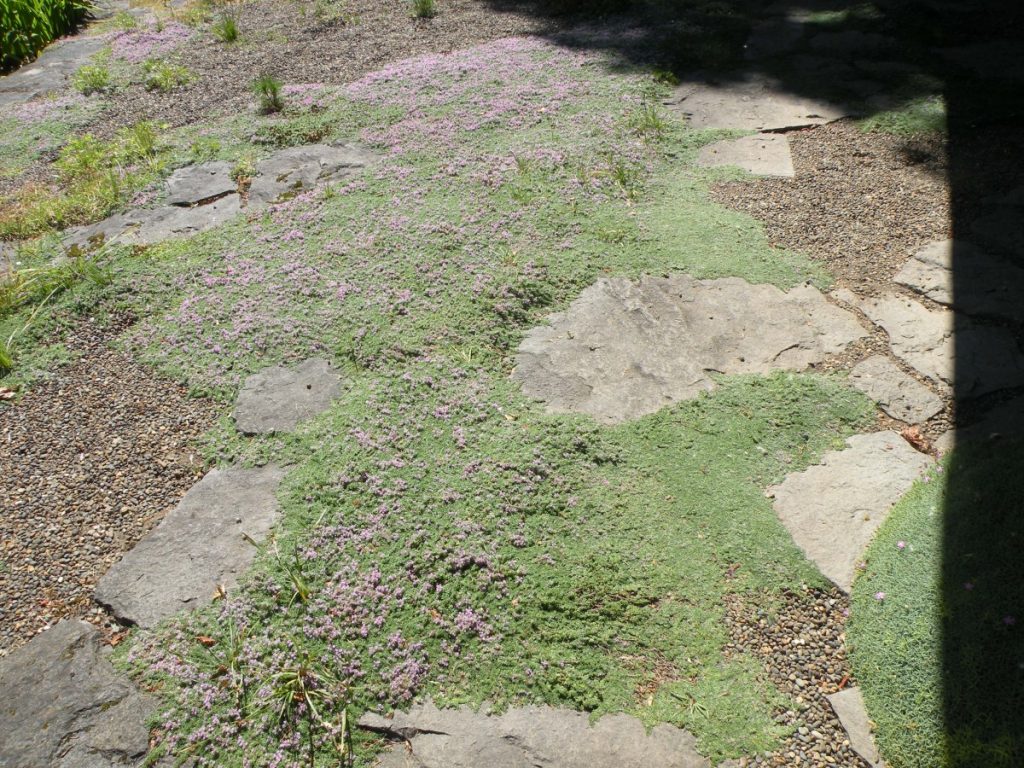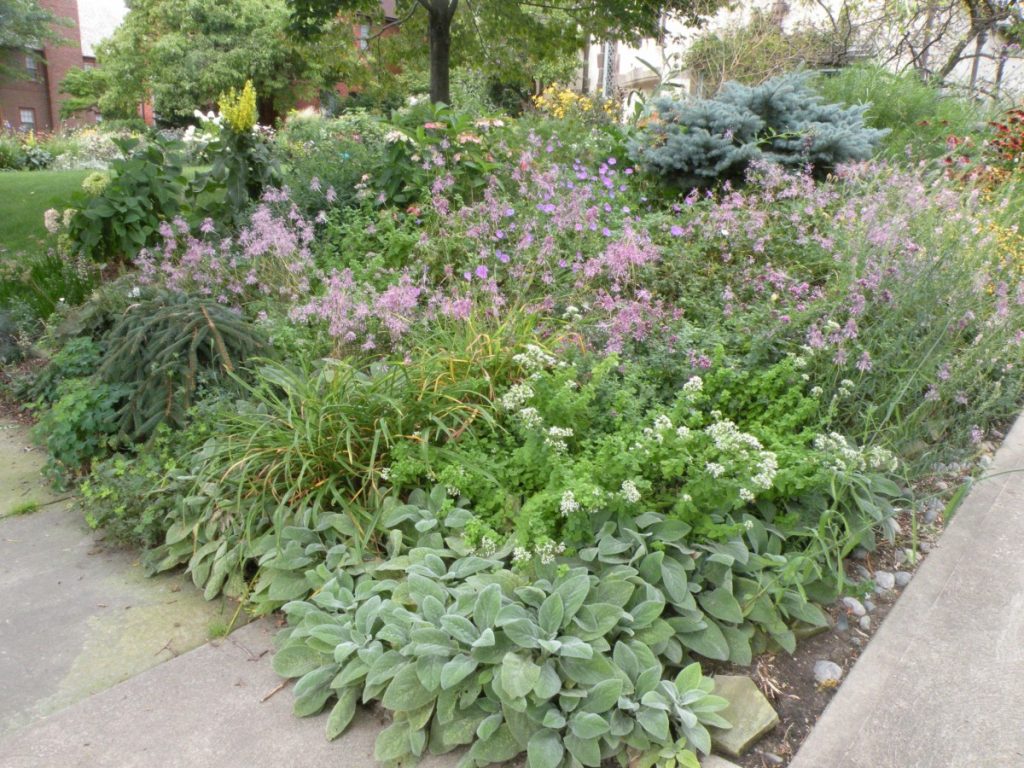I wish, as does almost every gardener, for more space. Then I could have an herb garden, a woodland garden and a fall border as well as my perennial garden. This is not to be, however. Thus, I incorporate them all into the general landscape with perennials and ornamental grasses leading the way. There are, of course, woody ornamentals which provide the bones of the landscape as well as bulbs, annuals, vines, and herbs. Many of the herbs are useful in the commercial landscape because they are extremely durable and require very little maintenance.
Herbs lend fragrance, colorful foliage, and flowers. The first that comes immediately to mind is Thyme. Its tiny leaves impart a texture different from that of most other plants in the perennial garden. Thymus serpyllum (Creeping Thyme) is a very low (1-2”), tight creeper that I use on slopes, in the garden, and between stepping stones. It has woolly foliage and pale lavender-pink or white flowers that bloom in May and June. The flowers are rich in nectar and loved by bees and butterflies. Another good creeper is Thymus praecox ‘Coccineus’ which has evergreen foliage and hot pink flowers.

I would like to use the woody, more aromatic thymes in the garden but have been frustrated by their inability to survive Cleveland winters. It is possible that they succumb because of poor drainage in my garden rather than lack of hardiness since they, like most thymes, are rated hardy from zones 5 to 8. My favorite is Thymus vulgaris ‘Argenteus’ (Silver Thyme) wherever I want small but white and green variegated foliage. This one usually survives in my pedestal container.
Oregano is another valuable addition to the perennial garden. There are two types: culinary and ornamental. The most common culinary oregano is Origanum vulgare. It has woody stems and spreads quickly by rhizome. I’ve had the subspecies hirtum (True Greek Oregano) on my sunny and dry east hill for thirty years but have to control its spread so that it does not smother everything else. It has lovely white flowers in mid-summer.

I became acquainted with Origanum laevigatum ‘Herrenhausen’ in the early nineteen nineties. It came to us from the German estate called Herrenhausen which was the home of some of their eighteenth and nineteenth century nobility. Planted on 18″ centers, it fills in fairly quickly and seeds a bit but not so much as to be troublesome. Hardy to at least zone 6, this Oregano has reddish-purply-green foliage. The flower spikes, which do not appear until mid-July, are pale lilac to purple and hold themselves above the foliage so that the ultimate height of the plant is approximately 18-24″. A similar oregano that looks particularly fetching at the edge of a rock wall or between rocks is Origanum x‘Rotkugel’. It has tiny green and white variegated foliage and 10” spikes of pink flowers in July and August.

driveway.
Salvias are an incredibly large genus that includes species which are annual, half-hardy perennial and hardy perennial. Many of these, such as Salvia x superba, are mainstays of the perennial garden but are not really considered as herbs even though their common name is Sage. Salvia officianalis (zones 4-7) has been used as a food flavoring for centuries but it is only in the past hundred years that it has also been recognized as a colorful addition to the perennial garden.
The passion for purple-leaved plants has brought Salvia o. ‘Purpurascens’ to prominence. The grainy texture and ovate shape of the foliage make this plant an excellent foil for delicately foliaged plants such as those mentioned immediately below. It is 12-20″ when in bloom and, of course, much lower when not in bloom. This makes it an excellent plant for the foreground where it can sit in front of purple or pink flowered Linaria purpurea (Toadflax) or one of the purple-flowered hardy geraniums such as Geranium ‘Rozanne’. Salvia o. ‘Tricolor’ is another useful cultivar (especially when sited near a purple foliaged plant such as Penstemon digitalis ‘Blackbeard’ or Sedum SunSparkler ‘Plum Dazzled’). Salvia o. ‘Aurea’ (Golden Sage) can be used to add a bright spot to the garden. All three sages grow 12-18” tall and wide and have an unusual stippled texture.

For me, one of the old standbys (which does not lessen its value) of the perennial garden is Nepeta (Catmint). I most often use Nepeta ‘Dropmore Hybrid’ at the edge of a walk or a wall so that I can enjoy its sprawling foliage and its floriferousness. In an average year, I usually coax three flushes of bloom by pruning it back after each flush. However, there a multiplicity of newer cultivars that are also very useful depending on the height you wish. My ‘Dropmore Hybrid’ faces south but is in part shade for several hours. If it were in full sun, it would probably not sprawl.

I can attest to the fact that Beebalm has been planted in herb gardens for centuries (having seen it in a twelfth century monastery garden in France), to alleviate various ailments. But as beautiful as the flowers are, the foliage usually becomes disfigured with powdery mildew. You can, of course, prune the plants when this happens and they will regenerate unmildewed foliage but a better solution is planting some of the newer cultivars that are at least mildew resistant and, in some cases, seem to be mildew proof. Monarda ‘Jacob Cline’ appears to be the best of the red flowering cultivars, highly superior to Monarda ‘Gardenview Scarlet’. Excellent pink cultivars are ‘Marshall’s Delight’, ‘Raspberry Wine’ and ‘On Parade’ (magenta). These mildew resistant cultivars are generally taller (4′) than those that are Monarda didyma cultivars because they have been crossed with Monarda fistulosa which is 4′ but very mildew resistant. There are several dwarf cultivars now but deadheading them is hard on the back. Just keep in mind that beebalms want to spread, even in clay soil and would probably cover the earth if left unimpeded.

Keep in mind that all herbs do best when given excellent drainage and full sun. It may be heresy to say so, but who needs an herb garden when you can integrate the best of them into your perennial garden or commercial landscapes?


1 Comment